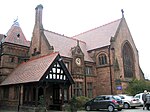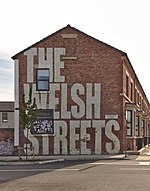Dingle railway station
Disused railway stations in LiverpoolFormer Liverpool Overhead Railway stationsPages with no open date in Infobox stationRailway stations in Great Britain closed in 1956Railway stations in Great Britain opened in 1896 ... and 2 more
Railway stations located underground in the United KingdomUse British English from February 2018

Dingle railway station is a disused underground railway station located on the Liverpool Overhead Railway (LOR), at the south end of Park Road, Dingle, Liverpool. It was the only below ground station on the line. Trains accessed the station via a half-mile tunnel, bored from the cliff face at Herculaneum Dock to Park Road. It is the last remaining part of the Overhead railway, with the surface entrance still standing. The former platform and track area were in use as a garage called Roscoe Engineering until 2015.
Excerpt from the Wikipedia article Dingle railway station (License: CC BY-SA 3.0, Authors, Images).Dingle railway station
Kedleston Street, Liverpool Dingle
Geographical coordinates (GPS) Address Nearby Places Show on map
Geographical coordinates (GPS)
| Latitude | Longitude |
|---|---|
| N 53.3814 ° | E -2.9584 ° |
Address
Kedleston Street
Kedleston Street
L8 9RP Liverpool, Dingle
England, United Kingdom
Open on Google Maps








